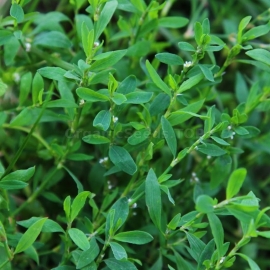




Organic Knotweed Seeds (Polygonum aviculare)
3.00 €
An annual herb with a height of 10-80 cm, which every year reproduces by self-seeding, a polymorphic species of the genus Highlander, a group of similar and difficult to distinguish species is united under the general name.
-
Polygonum aviculare or common knotgrass
An annual herb with a height of 10-80 cm, which every year reproduces by self-seeding, a polymorphic species of the genus Highlander, a group of similar and difficult to distinguish species is united under the general name.
Popular names: knotweed, bird buckwheat, goose grass, murava grass.
Medicinal plant, fodder (for poultry). Young leaves can be eaten in salads, soups, and mashed leaves. In Dagestan, it is used for filling pies.
It thrives on well-fertilized soil, forming a continuous carpet (popularly called "grass-murava"), suppressing other plants. Dyes are obtained from the grass (blue from the roots).
The Russian name "Sporysh" was given to the plant for its ability to quickly restore damaged shoots. In East Slavic mythology, knotweed is a symbol of fertility.
Stem up to 60 cm long, highly branched, erect, recumbent from the base, less often ascending or prostrate. The nodes are strongly pronounced. After flowering, the stems are hard.
The root is thicker than the branches, pivotal, slightly branched.
Leaves are small, alternate, elliptical or linear-lanceolate 1.5-5 cm long and 0.4-1.5 cm wide, with short petioles, entire, always without pinpoint glands, grayish-green. At the nodes, small whitish membranous bilobed bells 7-13 mm long are noticeable.
The flowers are small, with pale green, pink or white lobes along the edges. Bunches of flowers of 2-5 are located in the axils of the leaves, the plates of which are much longer than the flowers. The perianth tube is equal to its lobes. The perianth is simple, five-membered, approximately half incised, cracking at fruit, white or green with pink edges. 8 stamens, 3 pistils.
It blooms from April to almost the end of autumn, most intensely in July-August. The fruit is an almost black or brown triangular matte nutlet, almost equal in length to the perianth.
The fruits ripen in July - September.
It grows on trampled fields, wastelands, river banks, in yards, on paths, on roads, on pastures, permanent dry pastures, on ramparts, near dwellings, etc. Withstand trampling.
